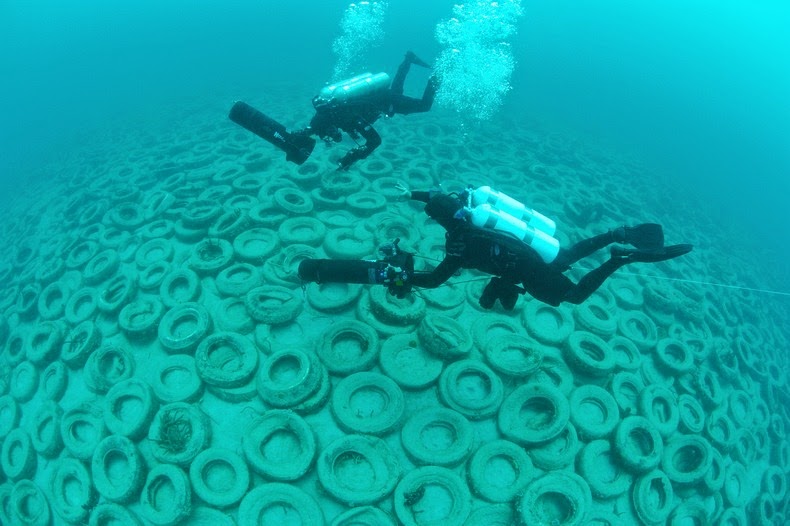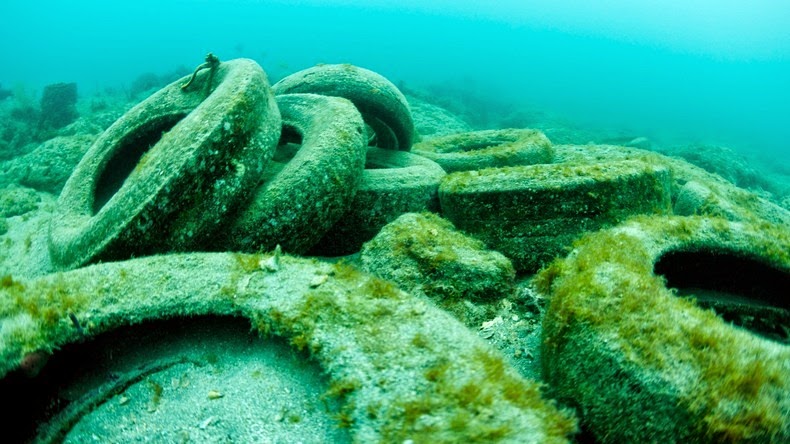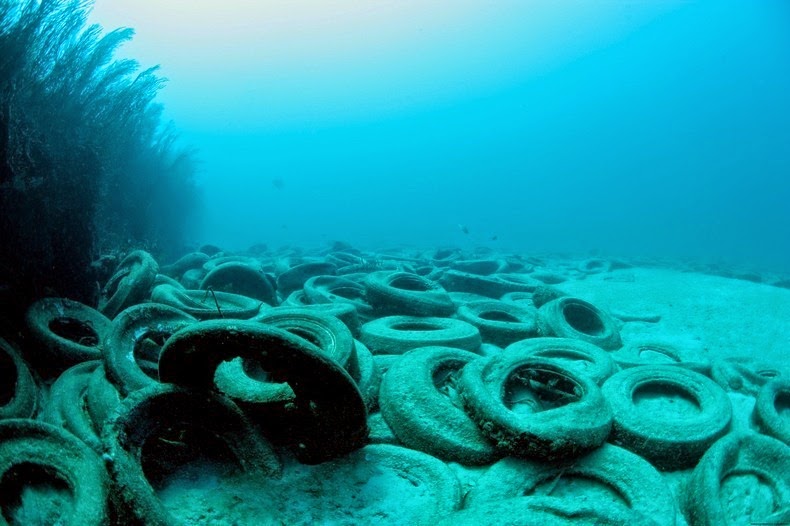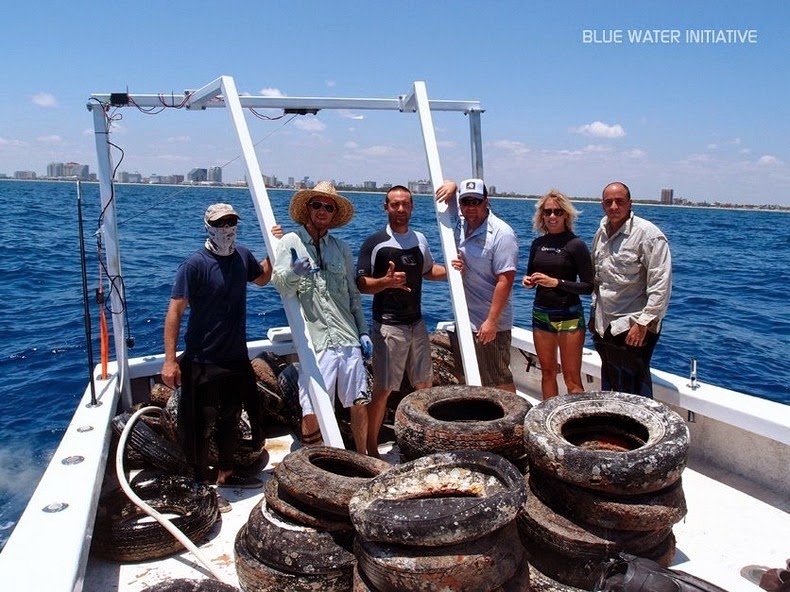
Problems
A Failed Artificial Reef of Discarded Tires
About 7,000 feet offshore of Sunrise Boulevard off the coast of Fort Lauderdale, Florida, lies an underwater wasteland of rotting tires. This is Osborne Reef, an underwater cemetery of 2 million tires that were placed there in the 1970s as a part of a failed ecological operation to create an artificial reef. Over the years, many of the tires were dislodged by tropical storms and hurricanes and caused damage to nearby existing coral reefs. Forty years later, the tires are still there causing more harm than good in the coastal Florida waters. Osborn Reef was the brainchild of a non-profit group called Broward Artificial Reef, or BARINC, composed of a group of fishermen, back in the spring of 1972. The idea was to create a reef using old tires that were piling up around the county's landfills and rural areas. This was before recycling caught on. They were convinced that corals would attach and grow on the tires and provide additional habitat for marine life. It was a well-intentioned but not particularly well thought out plan.
Gallery
4Timelines
2021
January 01
In 2001, Dr. Robin Sherman of Nova Southeastern University was awarded a grant of US$30,000 (equivalent to $45,911 in 2021) by the National Oceanic and Atmospheric Administration (NOAA) to begin a tire removal program. She was able to coordinate the removal of only 1,600 tires from the reef, and at a estimated cost per tire of $17 .
2015
January 01
In 2015, the state contracted with Industrial Divers Corporation (IDC) to remove the tires. From 2016–2019, the Florida Legislature allocated $4.3 million to the project. As of November 2019, IDC was removing 2000–5000 tires per week, had accumulated a total of 250 thousand so far, and still had two thirds of the tires to go. By 2021, 4Ocean announced their plan to retrieve Osborne Reef tires in a 34-acre (14 ha) area north of the original drop site. The clean up would be partially funded by the sale of $29.00 bracelets made out of reef tires.
2009
June 24
In 2009, recovery began on July 24 with thirty Army and Navy divers at Hugh Taylor Birch State Park, where it was thought about 300,000 tires were caught against a natural reef. Loading the caught tires onto the Army craft Brandy Station, the first day's haul brought approximately 1,400 tires ashore. Wrapping up for the year in mid-August, Coastal America's William Nuckols told the Associated Press that cleanup efforts have thus far recovered approximately 73,000 tires from the reef. By the time other operations required the military to end their cleanup at Osborne Reef, 72,000 tires had been collected by soldiers, sailors, and coasters.
2008
May 01
In 2008, recovery stopped after 26 days on May 24 after retrieving 43,900 tires. That year, Florida spent approximately $140,000 (equivalent to $176,000 in 2021) on the cleanup, some of which constituted transport for the tires to a shredding facility in neighboring Georgia whereafter they were burnt as fuel at a paper mill. Key members of the 2008 cleanup effort were US Army Captain Russell Destremps and his 86th Engineer Dive Team.
2007
June 01
Beginning in June 2007, the United States military and Coast Guard began “DiveExEast 07" to ascertain the best and most efficient processes for the cleanup effort. Barring unforeseen operational commitments and engagements, military divers hope to use this project as a training platform for several years and "recover the maximum number of tires possible from day one." Coastal America, an office of the United States federal government was tasked with coordinating the cleanup of the reef; they were instrumental in finalizing the deal wherein the Florida government would allocate $2 million (equivalent to about $2.6M in 2021) to cover transport and recycling of the tires. Ken Banks with the Florida DEP estimated the project to take three to five years, and while that timeline won't allow for the removal of all two million tires, it should mitigate the majority of the damage they're causing to the corals and coastline, though Banks predicted it could take decades for the reefs to rebuild. Summer 2007 saw US Navy, Army, and Coast Guard divers based out of a Coast Guard base in Dania Beach, Florida working to clean the reef. The joint team first worked to remove the tires from where they were doing the most damage, abutting against natural reefs in the area. In 2007, the recovery effort brought approximately 10,000 tires ashore.
2002
June 01
In 2002, Florida and Broward County environmental officials began the long and arduous process of setting into motion a plan to remove the tires. An original estimate of between $40 and $100 million (equivalent to about $60M and $151M in 2021) led the Florida Department of Environmental Protection (DEP) to plan to arrange a deal with those companies whose construction damages the seabed and reefs. Where they would previously mitigate their destructive construction with replacement constructs for reefs, the state would require them to make their amends by removing tires from the Osborne Reef. This plan faced criticism by environmental groups who felt that this would only hasten the destruction of more marine habitats.
1972
January 01
In 1972, Broward Artificial Reef Inc. (BARINC) proposed the construction of an enlarged artificial reef to Broward County as a way to both dispose of old tires as well as lure more game fish to the area. Similarly designed reefs had already been constructed in the Northeastern United States, the neighboring Gulf of Mexico, Indonesia, Malaysia, Australia, and Africa. Gregory McIntosh, a BARINC employee, lauded the project to the attendees of a 1974 conference on artificial reefs: "Tires, which were an esthetic pollutant ashore, could be recycled, so to speak, to build a fishing reef at sea." With endorsement of the project by the US Army Corps of Engineers, the Broward County government approved the project in 1974. That spring, more than 100 privately owned boats enthusiastically volunteered to assist with the project; accompanied by the US Navy's USS Thrush, thousands of tire bundles were simultaneously dropped onto the reef. The Goodyear Tire and Rubber Company provided equipment for the auspicious undertaking, even supporting the project so far as to drop a gold-painted tire from a Goodyear Blimp to christen the site. The culmination of the project was the deposit of over two million tires bound with steel clips over 36 acres (15 ha) of the ocean floor, approximately 7,000 feet (2,100 m) offshore, and at a depth of 65 feet (20 m). Ultimately, little marine life has been successful in latching onto the man-made reef and the majority never even had the opportunity to do so. When deposited, while a few tires were individual loose entities, the majority were bound together with nylon or steel clips (or bands). As there were no exceptional efforts made to ensure the non-corrosivity of the steel restraints, they summarily failed—resulting in the loosing of over two million individual, lightweight tires. This newfound mobility destroyed any marine life that had thus far grown on the tires, and effectively prevented the growth of any new organisms. Furthermore, the tires were now easily subject to the tropical winds and storms that frequent the east coast of Florida, and continue to collide (at times with tremendous force) with natural coral reefs only 70 feet (21 m) away: compounding their futility with environmentally damaging side-effects.


